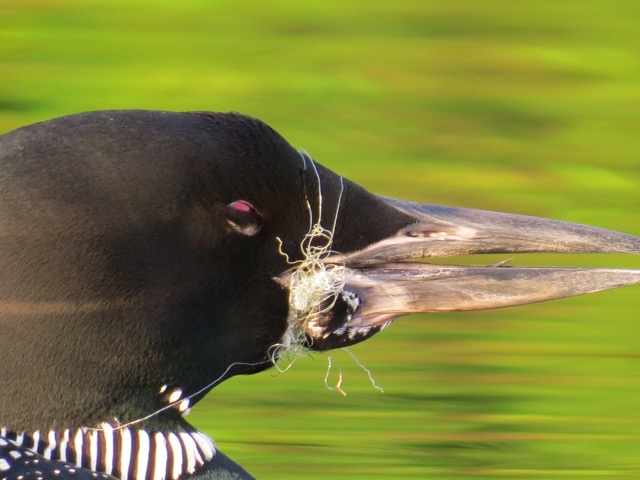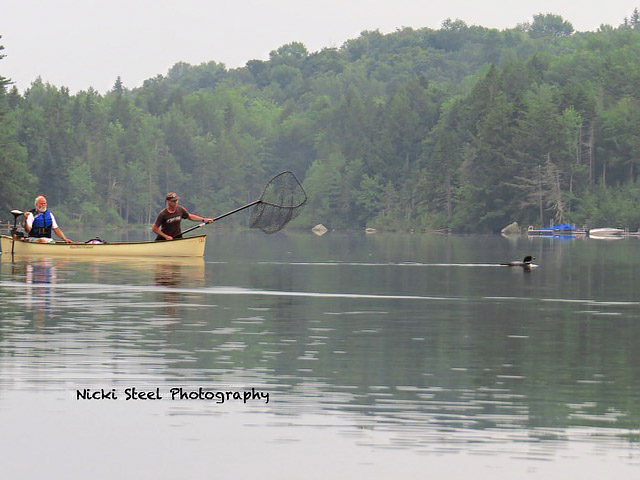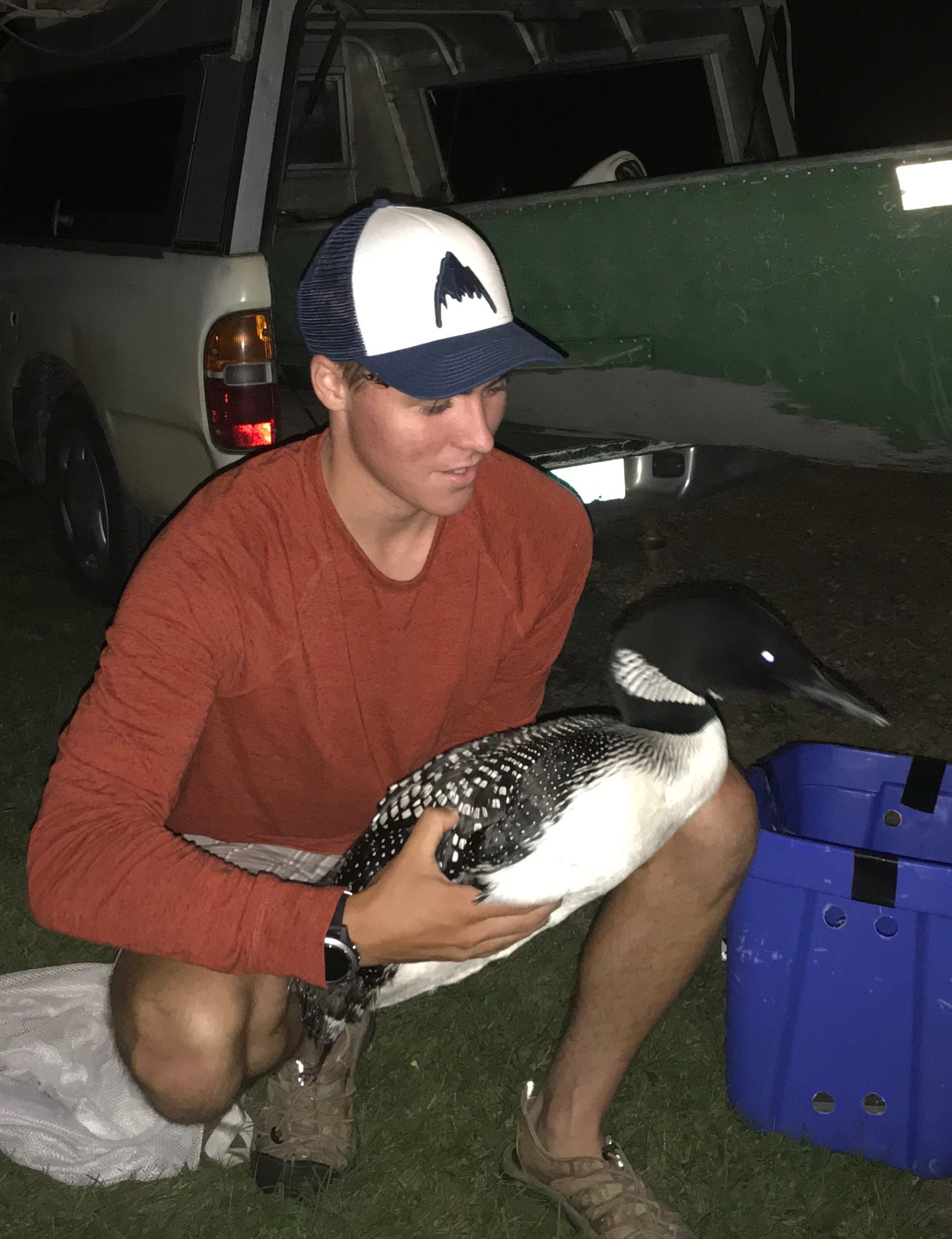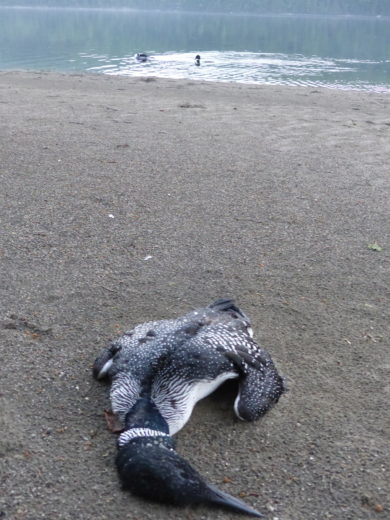
We have been monitoring this loon (known as Fish Line) on Lake Raponda in Wilmington, Vermont all summer. It can preen and catch small fish, and has avoided capture since early June. Photo: © Nicki Steel
Every year, some of our returning loons manage to get themselves into “hot water” so to speak. They ingest fishing gear, get sick, or land in the wrong places (like on roads, in fields, or ponds too small to allow loon lift-off)—and then my phone rings. We do our best to respond to every situation, which often includes calling on our dedicated volunteers to monitor a loon for days or weeks, or jump into a small boat with me in the dark of night with spotlights and a giant dip net to catch an injured loon. We attempt most captures at night because loons tend to follow spotlights, allowing us to get close with the net. Sometimes we are successful and the loon lives to migrate another year, and sometimes despite our best efforts, we are not.
We’ve been busy this summer. The following is a summary of rescues, attempted rescues, and recorded deaths for 2018 thus far. I’ll write again with a final update at year’s end.
Rescues and Attempted Rescues
Lake Raponda – June 2
I was helping VCE volunteer Henry Dandeneau place nest warning signs around a nest island when I noticed a sleeping loon very near shore. Something was amiss. Upon closer inspection, we saw that the loon had fishing line wrapped around its bill and head. Its mate sat nearby on the island nest, incubating eggs. Henry and I went right to work hatching a plan to return for a rescue attempt. By the time I made the 3.5 hour drive south for the second time a few days later, the pair had abandoned the nest. The loon (we call it FL—Fish Line loon) had re-joined its mate out on the main lake and easily avoided our nighttime spotlighting capture attempts, diving every time we got close. In fact, we only saw FL twice in over 90 minutes of searching. Wilmington resident and VCE volunteer Nicki Steel continues to monitor FL three to four times a week. She observes it dive, preen, and eat small fish. The fishing line has loosened over time, but has caused an infection at the base of the bill. FL catches larger fish, but cannot eat them. We’ve tried two more capture attempts to no avail. Nicki and others will continue to follow FL into the fall and report on whether it weakens or seems well enough to fly and migrate on its own.

In late July, we tried a third attempt at catching FL during both daylight and at night after it was observed sleeping more and possibly weakening. FL evaded capture once again. Photo: © Nicki Steel
Marshfield – June 17
A loon showed up on the lawn (yes, the lawn!) of a Vermont State Parks employee who lived not far from Knob Hill Pond. How in the world did the loon get there? Did it crawl out of the pond looking for bigger waters? Did it crash land while flying at night? We will never know. Since I was not available that day, staff from the Vermont Institute for Natural Science (VINS) stepped in. After determining there was nothing wrong with the loon, VINS staff released it on Knob Hill Pond, which did not host territorial nesting loons and was therefore safe for our grounded bird. Happily, the loon left within the week, most likely to fish in nearby ponds in Calais, Woodbury, or Marshfield.
East Hardwick – August 9
A loon landed on a 100-foot long pond in Michelle Demers front yard, taking up residence with their eight-foot inflatable pink Flamingo. Michelle and her family watched the loon try to take off several times, but it consistently bailed out before reaching the bank. I arranged for the use of gill net from Vermont Fisheries Essex office just in case we could not catch it using spotlights and a dip net. I gathered my 20-year-old son, Anders, and a good friend of his, Jacob Morse, for a Monday night of entertainment in the Northeast Kingdom–a loon round-up.

Eric Hanson’s son, Anders Hanson, releases an about-to-be happy loon on Caspian Lake. The loon spent the previous five days stuck on a 100-foot long pond with an inflatable pink Flamingo in East Hardwick, VT.
We hauled a borrowed 12-foot fishing boat, spotlights, trolling motor, and batteries to the shore. The loon called, probably wondering what the ruckus was all about. Every time Anders trained the spotlight on the bird, it dove. I began to worry that this would be a repeat of Lake Raponda! After 10 minutes of trolling in circles, locating the loon, making approaches, and watching it dive again, we noticed the bird change behavior; it started to follow the spotlight and stay on the surface longer. I hooted, imitating another adult loon. We got closer. Jacob turned that boat around using the trolling motor, shifting from forward to reverse and back again, faster than I’ve ever seen. I finally had a chance to plunge the net in front of the diving loon, and we got it. We adorned the loon with yellow, green, and silver bracelets (leg bands) and released it on Caspian Lake, a few miles up the road. I’d hire Jacob and Anders for any capture crew!
Reported Deaths
We know that death is an inevitable part of life—and while it is never easy to record a loon death, we need this information to further our research and conservation work to ensure a healthy Vermont loon population well into the future. Here is a summary of loon mortalities recorded so far in 2018.
Molly’s Falls Reservoir – May 30
Green Mountain Power was in the process of repairing the dam on this reservoir, which required maintaining a low water level until the repair work was completed. It turns out that on this lake, low water levels made for much more difficult loon work! VCE interns Alex Kulungian and Tara Rodkey helped me literally roll and push two loon nesting rafts across 100 feet of mudflats to be placed in the water where the loon pairs were waiting.

Paddlers reported this loon mortality on Molly’s Falls Reservoir in early June. The resident pair watches on, likely concerned about activity on a potential nesting island. Photo courtesy of Eric Hanson.
The next day I received a report of a dead loon on the island, where the newer “island” pair has nested several times. As I paddled by the “north” pair’s nesting raft, I noted that a loon had taken up residence within 48 hours of our placing the raft in the water. That’s quick. When I arrived at the island, I saw the second loon pair right off shore and a dead loon up on the sandy beach. Did it lose a fight in a territorial battle? I collected the bird and sent it to Tufts Wildlife Clinic for a necropsy. Later this year, we’ll receive their report and I’ll post an update on this loon’s cause of death.
Back to the island pair: they nested on their raft a week or so later. We’re glad they have shifted nest sites from the island to the raft, because the island is a popular picnic spot and camping location.
Nelson Pond – July 16
Lake residents observed a loon that appeared weak and made raspy breathing noises. The next morning they found the loon had beached itself. A vacationing veterinarian from Dummerston, Dr. Ron Svec, put the bird in a container so I could retrieve it and bring it to Dr. Robert Hoppe in St. Johnsbury. Dr. Hoppe performed an x-ray, which showed that one lung was filled with fluid. Next I called on Dr. Mark Pokras, a retired Tufts University expert on loon mortality, who surmised that Aspergillosis, a fungal disease, had very likely taken over the lung. We could see a two-inch metal object in the body as well (partially dissolved fishing hook?), which might have caused the initial infection allowing Aspergillosis to take hold. Unfortunately, we had to euthanize the loon, and sent it to Tufts for further analysis. Despite the loss of the loon, this unfortunate event brought three collaborating veterinarians together in an attempt to save its life.
Thurman Dix Reservoir – August 26
VCE volunteer Cindy Grimes called from the shores of Thurman Dix reservoir after finding one mate of a known loon pair dead near shore. She was extremely upset since these were “her” loons, as she had spent from three to four hours every Sunday watching them, along with other birds in the area. I drove down to pick up the bird, further evaluate the situation, and talk things over with Cindy. The other adult and nine-week old chick seemed to be healthy. She had observed a loon beaching itself several times over the previous three weeks, but the same loon would also be found in the water acting normally. Intruder loons were common this summer, so could this bird have been injured in a fight? Or had it caught a disease? Once again, I sent the deceased bird to Tufts for further evaluation to determine the cause of death.
This summary illustrates citizen science in action—people taking the time to report on or directly help save a loon in trouble, or help us figure out how they died. It can be heart-wrenching to monitor a distressed bird, or to come across one that has died. Thank you all for your participation, which greatly contributes to our conservation and education efforts now and into the future.

we never heard the necropsy results of the dead loon we found on Berlin Pond in summer of 2016…we are pleased to see loons doing well there, and wonder what happened to that poor loon.
Hi Sheila, Good timing with your question about previous year mortalities. A few weeks ago, I received an updated list of necropsy results from Tufts University Wildlife Clinic. VCE sends all retrieved loon mortalities to them. Dr. Mark Pokras leads the charge to do a detailed analysis of why loons die across the northeast United States. Even though Mark is retired, he still goes to the school do continue this service. They find the funds to keep doing necropsies as they can fit them in.
Back to the Ricker Pond adult loon from 2016. The official cause was not determined but several factors could have contributed to the loon’s death. It had slightly elevated lead levels and part of a fishhook in the body, but not high enough lead toxicity (at the time of the necropsy) to determine that lead was the cause. There were also several healed puncture wounds possibly from previous loon fights. It is very likely this loon lost a fight with another adult loon and a chance that it was more vulnerable because of elevated lead toxicity levels. For some reason, Ricker Pond has been the target of intruder loons for nearly 10 years now. It’s been at least 7 years since a chick has survived with many killed during these territorial battles. It’s a sign that Vermont’s loon population is actually doing well when loons have to compete like this and keeps loon numbers from rising too quickly. It’s not great for Ricker Pond and those that would like to follow the chicks to migration time. Here is the exact wording from Tufts on their analysis:
“significant signs of previous trauma — multiple healed sternal punctures, a variety of small internal blood clots. Recent puncture of abdom. musculature (although skin had healed), with significant blood in coelom and L abd airsac
Significant load of tapeworms in sm bowel
interesting to speculate whether elevation in Pb might have played a role in bird’s demise
probable loon trauma based on observed history”
Thanks Tufts for continuing this great work which helps guide our conservation efforts here in Vermont.
Great work Eric. We luv our loons here at Willoughby Lake.
We recently watched two groups of loons meet here in front of us. They put on a show with loud ‘loon music.’
The two groups appeared to not like each other as they fluttered, dove, splashed, swam in circles, took off ‘running’ and would quickly swim back. They all survived and later went their separate ways. It was an interesting event to watch.
I did record some beautiful loon sounds.
Tonight a loon came unusually close to shore. It then looked like it was sleeping 3ft from shore then it made its way into corner of a dock and shore and was not scared off by human presence – quiet and respectful but still allowed people unusually close. I was unnerved and worried sick or dying. It later went back out into lake. Not sure if we should be concerned?
Caspian Lake, Greensboro VT
Hi Jennifer, There is a chance something is not quite right with this loon (disease, injury, exhaustion if dealing w/ territorial pair). But it could also be in resting mode, really used to people being around, and trying not to gain the attention of the territorial loons. There is not much we can do for low-energy loons except monitor. Loons do not do well in captivity. If it does beach itself and take a turn for the worse, we can try to capture it and have an initial assessment done by a vet or VINS. Keep on watching and email me directly or call if it does beach itself. 586-8065 (in Craftsbury). eric hanson